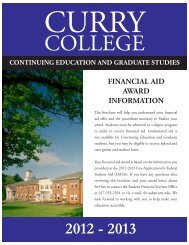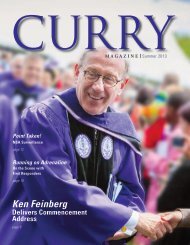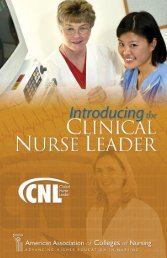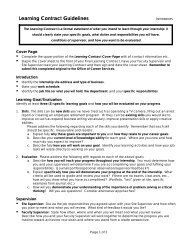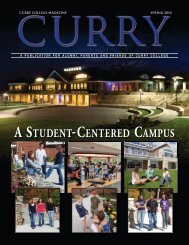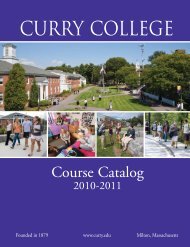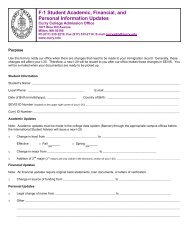Read the Curry College NEASC 2012 Self-Study Report.
Read the Curry College NEASC 2012 Self-Study Report.
Read the Curry College NEASC 2012 Self-Study Report.
Create successful ePaper yourself
Turn your PDF publications into a flip-book with our unique Google optimized e-Paper software.
87<br />
• Increased Cash and Investments, net of any outstanding balance under <strong>the</strong> working<br />
capital line of credit, by $70 million.<br />
• Increased net Fixed Assets by $64 million. The principal additions were an academic<br />
building, a student center, and two residence halls.<br />
• Increased Debt, net of <strong>the</strong> related Debt Service Reserve Fund, by $50 million.<br />
• Increased net Fund Balances by $79 million.<br />
• Increased traditional student enrollments by 583 students, or 47%, from 1,233 to 1,816<br />
(as measured in full‐time paying equivalent students). Residential students accounted<br />
for most of <strong>the</strong> increase; putting <strong>Curry</strong> at 94% of its residential capacity.<br />
These results demonstrate <strong>the</strong> success of <strong>the</strong> <strong>College</strong>’s strategy of incurring debt responsibly to<br />
fur<strong>the</strong>r its core mission by simultaneously increasing enrollments and generating institutional<br />
resources. The <strong>College</strong>’s debt service burden was 4.8% in 2001, and 7.5% in 2010 (considered<br />
moderately high by Standard & Poor’s); it decreased to 7.2% in 2011 and is budgeted at 7.0% in<br />
FY12. The <strong>College</strong>’s debt service coverage ratio was 1.64 times in 2001, 3.49 times in 2010, 3.93<br />
times in 2011, and is budgeted at 1.61 times in <strong>2012</strong>. (The <strong>2012</strong> budget does not include any<br />
endowment income and includes a 3% expense contingency.) The <strong>College</strong> has not incurred debt<br />
for five years, but has budgeted in <strong>2012</strong> for a $3 million capital expenditures financing for<br />
academic and faculty space improvements.<br />
The <strong>College</strong> has both budgeted and realized a surplus of revenues over expense each year since<br />
its last full evaluation in 2002. The composition of <strong>the</strong> <strong>College</strong>’s surpluses of revenue over<br />
expenses has changed in recent years, with increasing endowment earnings offsetting a<br />
negative trend in income from operations. The most significant factor affecting operations has<br />
been an increasing discount rate, from 26.7% in 2008 to an anticipated 32.8% in <strong>2012</strong>, during a<br />
period (FY2008 to <strong>the</strong> present) when traditional student enrollments have not increased. This<br />
higher level of institutional aid reflects <strong>the</strong> change in <strong>the</strong> economy, changing demographics<br />
with students of increasing need, and <strong>the</strong> intensely competitive marketplace with increasing<br />
non‐need‐based financial aid awards. (Historical schedules of traditional student enrollments<br />
and costs of attendance are provided in <strong>the</strong> workroom.)<br />
An additional factor that impacts income from <strong>the</strong> <strong>College</strong>’s core operations is <strong>the</strong> fringe<br />
benefit rate which, as a percentage of total faculty and staff salaries, was 24.6% in 2001, 31.0%<br />
in 2008 when traditional enrollments peaked, and expected to be 32.1% in <strong>2012</strong>.<br />
The <strong>College</strong>’s five‐year financial institutional aid model shows <strong>the</strong> discount rate increasing to<br />
approximately 37% by 2015. (This model is provided in <strong>the</strong> workroom along with <strong>the</strong> <strong>College</strong>’s<br />
multi‐year financial model.). Although <strong>the</strong> discount rate is increasing, it is currently moderate to<br />
low by industry standards, <strong>the</strong>reby providing some flexibility in responding to <strong>the</strong> intense<br />
competition for students as well as supporting potential retention and persistence initiatives.<br />
<strong>Curry</strong> has been successful in managing its balance sheet to minimize <strong>the</strong> need for borrowing. In<br />
2001, <strong>the</strong> <strong>College</strong> had student accounts receivable of $841,000 and a bad debts provision of<br />
$275,000 on student revenue of $29.2 million. Over <strong>the</strong> past ten years, <strong>the</strong> <strong>College</strong> has<br />
<strong>Curry</strong> <strong>College</strong> <strong>2012</strong> <strong>Self</strong>-<strong>Study</strong><br />
Standard Nine




